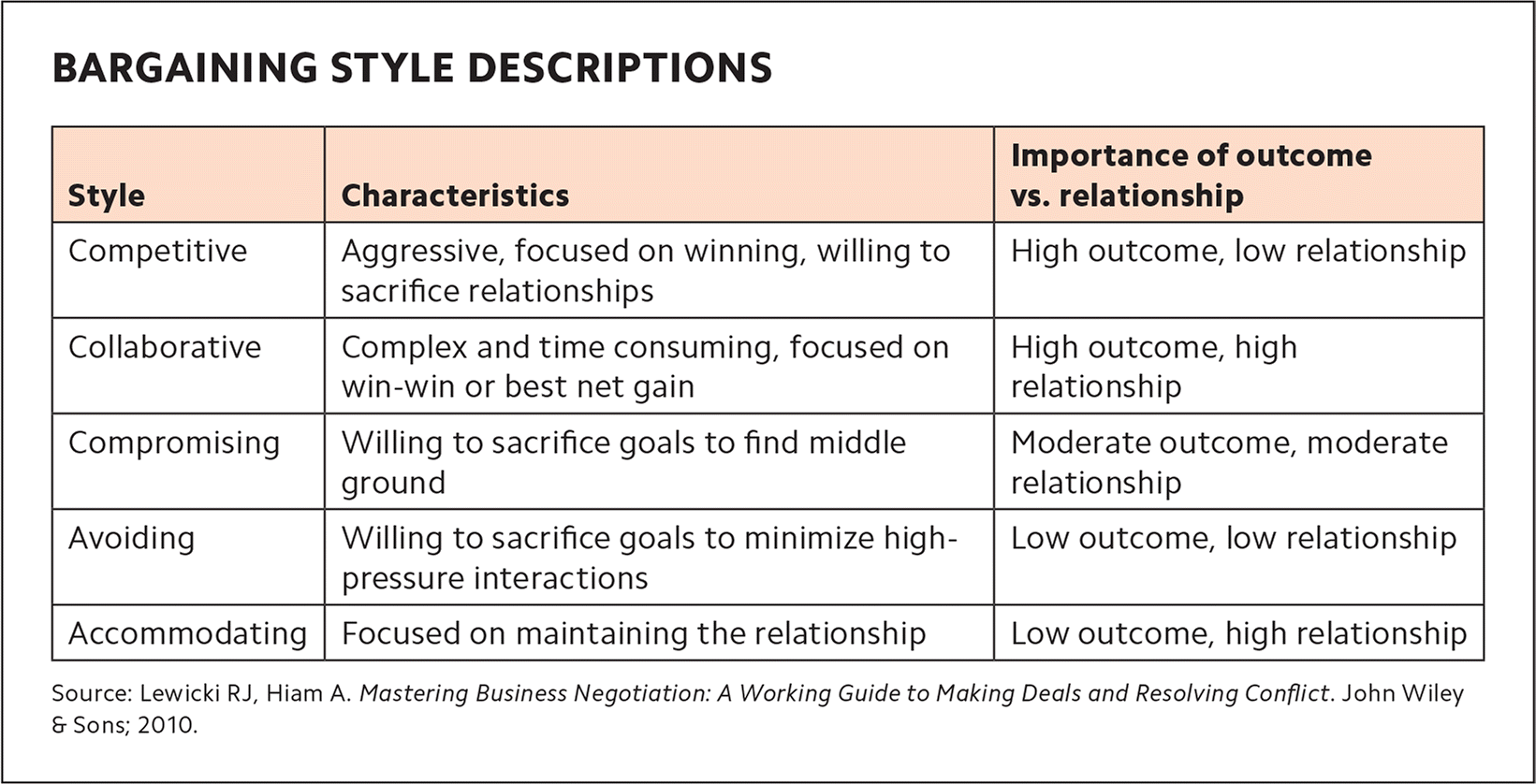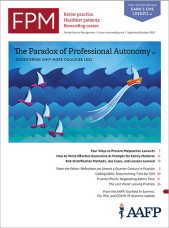
The right style and tactics make it easier to effectively advocate for yourself, your patients, and your team and reach “win-win” agreements.
Fam Pract Manag. 2023;30(3):10-14
Author disclosure: no relevant financial relationships.

Negotiation is an ever-present part of our lives, impacting physicians both personally and professionally. Often, when we think of negotiation in our professional lives, we imagine high-stakes situations like negotiating a salary with an employer or a business deal with a new partner or vendor. But it can take many other forms, such as negotiating with leadership to change a policy or process that affects patient care, to influence investment priorities to better support the primary care team, or to improve aspects of your employment contract (e.g., protected time for administrative work) so you can carry out your professional responsibilities more effectively.
Certain negotiation strategies can improve your odds of success, meaning the agreement not only meets your needs but leads to better outcomes for everyone involved. This article provides an overview of the five different negotiating styles, describes two tools that lay the groundwork for negotiation, and outlines five steps to reaching successful agreements.
KEY POINTS
Negotiation is often more fruitful if you know your own bargaining style and, if possible, the other party's bargaining style.
Keeping in mind your “best alternative to negotiated agreement,” or BATNA, helps you know when walking away from a negotiation is better than accepting a negotiated outcome.
For the best outcome, start by asking for more than you want and be prepared to make concessions as talks progress.
FIVE BARGAINING STYLES
When you enter a negotiation, you may encounter — and exhibit — five different bargaining styles:1
Competitive (focused on winning),
Collaborative (focused on win-win or best net gain),
Compromising (focused on finding a middle ground),
Avoiding (focused on minimizing high-pressure interactions),
Accommodating (focused on maintaining the relationship).
Although each of us tend to gravitate toward one style, we can draw on others as we need them, provided we understand and practice the styles that are less intuitive. Knowing our default style, as well as the style exercised by the other party, can greatly improve our success.
Each style prioritizes the importance of the relationship and the importance of the outcome differently. (See “Bargaining style descriptions.”) For example, the competitive style puts high value on the outcome and low value on the relationship. Thus, it is more aggressive, focusing primarily on results and prioritizing the best deal for one party at all costs. This style often achieves short-term results quickly, but the results can come at the expense of the negotiating parties' relationship. The collaborative style tends to focus on finding winwin outcomes and identifying mutually beneficial solutions to complex problems. This style may take more time, but often results in better long-term relationships and agreements that maximize the benefits to both sides. The compromising style prioritizes finding middle ground that can meet the needs of all parties; however, rather than focusing on a true “win-win” with a more complex solution, it tends to sacrifice part of what each side wants to come to an agreement. The avoiding style involves remaining neutral and minimizing tense or high-pressure interactions. Individuals who use this style are less aggressive at pursuing their goals and more focused on rapidly reaching an agreement to end the negotiation process. The accommodating style prioritizes the relationship between parties over the outcome of the negotiation, often sacrificing the optimal deal to maintain strong relationships.

| Style | Characteristics | Importance of outcome vs. relationship |
|---|---|---|
| Competitive | Aggressive, focused on winning, willing to sacrifice relationships | High outcome, low relationship |
| Collaborative | Complex and time consuming, focused on win-win or best net gain | High outcome, high relationship |
| Compromising | Willing to sacrifice goals to find middle ground | Moderate outcome, moderate relationship |
| Avoiding | Willing to sacrifice goals to minimize high-pressure interactions | Low outcome, low relationship |
| Accommodating | Focused on maintaining the relationship | Low outcome, high relationship |
Popular culture often depicts negotiation as a zero-sum game with a winner and a loser. This is known as “distributive negotiation”; it assumes there is a fixed amount of resources and the negotiation is all about how they're distributed. “Integrative negotiation” is different. It approaches negotiation not as a win-or-lose dichotomy but rather a process that adds value for both parties. Strong integrative negotiators can often find creative, mutually beneficial outcomes and build positive relationships that lead to better future negotiations and more value creation. It's a virtuous cycle, and the collaborative bargaining style is the easiest way to get there.
TWO NEGOTIATING TOOLS
Once you understand the common bargaining styles, two tools can help you lay the groundwork for effective negotiation.
1. Zone of possible agreement. This is the overlap of acceptable outcomes for both parties in the negotiation. While it is rarely possible to know the other party's precise zone of possible agreement, certain clues during the negotiation (such as starting offers and counteroffers) can help you determine what the boundaries might be so you can lead the bargaining to an endpoint within that zone. If there is no zone of agreement overlap at the outset, you can often help shape the zone by highlighting mutual benefits, offering concessions, and using other means of persuasion.
Here's an example:
Dr. Fredrick is a practicing clinician with 10 years of experience working for his organization. While practicing clinical medicine has been fulfilling, he now wants to diversify his career with protected time for teaching. He believes 20% of his time would be ideal, but he would accept 10%. Thus, his zone of possible agreement is 10% to 20%.
Dr. Fredrick senses that his administrators are reluctant to reduce his clinical time at all. To move them into the zone of possible agreement, he tries to get them to see a mutual benefit. Dr. Fredrick mentions the considerable challenges in physician recruitment and points out that creating opportunities for students to engage with the health system could create a pipeline for future recruitment. This reframes the discussion so the investment in teaching time is no longer simply to retain Dr. Fredrick but also addresses long-term strategic goals for the health system, creating value for both parties. The administrators ultimately agree to set aside 15% of Dr. Fredrick's time for teaching.
2. Best alternative to a negotiated agreement (BATNA). This tool helps you evaluate whether continuing a negotiation is in your best interest.2 Put simply, BATNA is your fall-back option if the parties cannot reach an agreement and the negotiation fails. For example, your BATNA might be leaving your current employer and accepting an offer from another organization, or it might be giving up on changing your organization's overall policy and making smaller changes at the practice level instead. Clarifying this helps you know how hard you should negotiate to improve the terms of the agreement. If your BATNA is acceptable, you will have little to lose in the negotiation and may be more willing to push harder than if your BATNA is unsatisfactory.
Here's an example:
Dr. Taylor is a third-year resident considering career options. She is interested in teaching medical students and publishing on medical education. She already has an offer from a community health system for a full-time clinical role at a guaranteed salary of $235,000. She is currently talking to a recruiter for a local academic health system about another position with 80% clinical care, 10% teaching time, and 10% time to support academic output, which offers a guaranteed salary of $220,000. The academic job is more ideal for her, but knowing that she has the BATNA of the full-time clinical job to fall back on, Dr. Taylor pushes the academic health system hard in salary negotiations and they agree to increase her guaranteed salary to $240,000.
Having a clear BATNA also helps you know when to walk away from a negotiation rather than accept unfavorable terms. Here's how that might have looked in Dr. Fredrick's example:
Dr. Fredrick is feeling increasingly burned out and is prepared to quit and seek part-time employment if his health system cannot give him at least 10% protected time for teaching. Early in the negotiation, his administrators suggest that he can teach on his own time and would not need protected time to do it. Dr. Fredrick indicates that he needs protected time for it to be viable to engage with learners and that this added scope is essential to a sustainable career. The administrators refuse to budge. Dr. Fredrick says there is no room for further discussion if protected time is not possible and ends the negotiation. He went into the negotiation with a clear BATNA: It is better for him to quit and work part-time for a while than to accept a negotiated outcome that does not include at least 10% protected time for teaching.
These examples involve dedicated time for teaching, but the same principles apply whether you're asking for dedicated time in your schedule for administrative work, the addition of a scribe to your care team, support to add a new procedure to the practice, etc.
STEPS TO SUCCESSFUL NEGOTIATION
There are five basic steps in the negotiation process.
1. Research. Do your homework on the topic. For example, if the negotiation involves money, productivity, or other measures, identify some industry benchmarks or baseline data. If the negotiation involves a change in process or policy, identify best practices from similar organizations or from the literature so you have some evidence on your side. Do your homework on the other party as well. If possible, get a sense of their bargaining style, discussed earlier. Are they going to be open to collaboration, or are they more of the competing type determined to emerge as the “winner”? Speaking with colleagues who have negotiated with the other party in the past can help you gauge their style. You should also consider how much leverage you have with them, which will influence your goals and starting position.
2. Goals. Clearly establish your goals, including your desired outcome and your minimum acceptable outcome (i.e., your zone of possible agreement) as well as your BATNA, discussed earlier. Each of these elements will help you define your starting position.
3. Opening. It is best to anchor at a high starting position to begin a negotiation. You want to find the maximum plausible position — not unrealistically high, but high enough to allow you to make concessions while still achieving an outcome that meets your goals. There is no perfect way to identify the maximum plausible position, but it is generally higher than you think. If you are negotiating a contract, choosing a salary number slightly greater than specialty-specific benchmarks can be a good starting position. If you are negotiating with health system leadership to make a non-salary change (e.g., EHR functionality, change in work expectations, or protected time for nonclinical work), ask for more than you want. By anchoring high, you position yourself to achieve the goals you set prior to the negotiation, and you may even get more than you expected.
4. Counteroffers. After the initial request or offer, there will be a series of counteroffers. Be prepared to make concessions as the bargaining process progresses. Early on, larger concessions may be appropriate, but as the negotiation continues, moving to smaller concessions is best.
5. Reaching agreement. When agreement seems near, keeping an additional, small concession in reserve can be beneficial as a good-faith gesture that may improve the final position on which the other party is willing to settle. It also helps you end the negotiation on a positive note that supports future relationships.
Here's an example:
As Dr. Taylor begins the negotiation with the local academic health system, she knows the benchmark pay for her position is $245,000. As a new graduate, she is not sure she can get a benchmark offer, but knowing the relative shortage of family physicians, she decides to start with an initial request of $255,000. While it feels uncomfortable to request such a high salary, as the discussions continue she is able to offer concessions on items such as vacation time and on-call work to get other things she values, such as protected time for non-clinical work, while the two sides go back and forth on salary. Ultimately, she ends up agreeing on a salary of $240,000 — below the benchmark for her position, but above the offer from her second-choice position at the community health center. The salary is within her zone of possible agreement, and she also gets protected time to pursue her nonclinical interests.
STRIVE FOR WIN-WIN AGREEMENTS
Negotiation is an important skill that helps you achieve your goals with agreements that ideally are mutually beneficial for both parties. (For advanced topics in negotiation, see “More resources.”) Finding a “win-win” solution helps build relationships, which makes the next negotiation more likely to produce another win-win.
MORE RESOURCES
Cognitive biases
Neale MA, Bazerman MH. Negotiating rationally: the power and impact of the negotiator's frame. The Executive. 1992;6(3):42–51.
Gambits
Dawson R. Secrets of Power Negotiating: Inside Secrets From a Master Negotiator. 2nd ed. Career Press; 1999.
General negotiation
Voss C, Raz T. Never Split the Difference: Negotiating As If Your Life Depended On It. Harper Business; 2016.
Negotiation can involve compensation and salary discussions, time allocation, scope of responsibility, process, policy, and many other facets of work in health care. Understanding the parties to the negotiation and your goals are critical. Careful planning around your starting request and subsequent discussions can help you achieve your desired outcome. Finally, keeping in mind a clear BATNA can help you walk away from a negotiation when it becomes clear that any negotiated outcome will be less desirable for you than leaving with no agreement.
